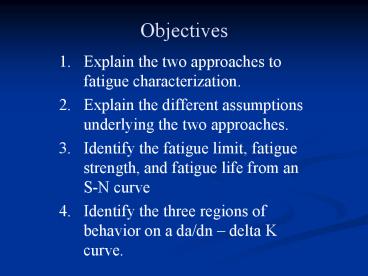Objectives - PowerPoint PPT Presentation
1 / 23
Title:
Objectives
Description:
Identify the fatigue limit, fatigue strength, and fatigue life from an S-N curve ... Stress exceeds yield strength. Very few cycles to failure. Lots of plastic ... – PowerPoint PPT presentation
Number of Views:96
Avg rating:3.0/5.0
Title: Objectives
1
Objectives
- Explain the two approaches to fatigue
characterization. - Explain the different assumptions underlying the
two approaches. - Identify the fatigue limit, fatigue strength, and
fatigue life from an S-N curve - Identify the three regions of behavior on a da/dn
delta K curve.
2
The Three Horsemen of Engineering
- Fatigue
- Corrosion
- Wear
Durer
3
Fatigue
- Cyclic Load/ Strain
- Extended time failure process
4
Two Types of Fatigue
- High Cycle
- - Stress below yield strength
- - Macroscopically brittle
- - May be very long life
- Low Cycle
- Stress exceeds yield strength
- Very few cycles to failure
- Lots of plastic deformation
5
Terminology
- Mean Stress
- Range
- Stress Amplitude
- R Value
6
Two Engineering Approaches to Fatigue
- 1. Assume a flaw free structure
- - initiation of flaw dominant
- - safety factors to account for flaws
- 2. Assume presence of flaws of known type
- - fracture mechanics for prediction
- - measurement/ monitoring required
7
High Cycle Fatigue Process
- Local yielding at a defect or in a stress
concentration (filet root, scratch, bend, hole) - Dislocation pile up/ saturation
- Crack formation
- Crack propagation (relatively little of the life)
8
S-N Approach
Multiple Specimens Different Stresses Cycled to
Failure
BCC HCP Metals
9
Fatigue in FCC Alloys (Al)
7075-T6 Aluminum notched, constant load
amplitude
Hardrath et al, NASA TN D-210
10
Effect of Notches Cold Working
11
S-N Approach
- Assumes Flaw Free Structures or structures with
flaws just like the test specimens. - Implies that most of the life of a structure
occurs during crack INITIATION!
12
Fatigue Limit vs. Hardness
Metals Handbook, Vol 1, ASM Int.
13
Relation between rotating, bending unnotched
fatigue strength and tensile strength, for alloy
(?) steels and carbon (x) steels
14
(No Transcript)
15
Limitations of S-N
- Massive Scatter
- Initiation and propagation not separate
- Mechanisms change based on stress
- Low cycle plastic deformation
- High cycle purely elastic deformation
16
The FCP Process
- Sharp Crack closed
- Stress opens crack
- Tip of crack blunts
- Crack closure/ sharpening
- Repeat
17
The Fatigue Process
- Sharp Crack closed
- Stress opens crack
- Tip of crack blunts
- Crack closure/ sharpening
- Repeat
- Note Large load large plastic zone
- large compressive stress difficult crack
- opening on next cycle
- Thus periodic overloads during fatigue
- may actually slow the failure process
18
(No Transcript)
19
Load Order Is Significant
- l low load cycle h high load cycle
- hhhhhhhhlllllllllllllllllllllllllllll best
- lllhlllhlllhlllhlllhlllhlllhlllhlllh
- hhlllllllhhlllllllhhlllllllhhllllllh
- lllllllllllllllllllllllllllllhhhhhhhh worst
20
Effect of Stress Level on FCP Rate
21
Effect of constant Delta-K Values
22
Monitor Stress Intensity and Crack Speed da/dN
Delta K
23
Real Data for Stainless Steel































